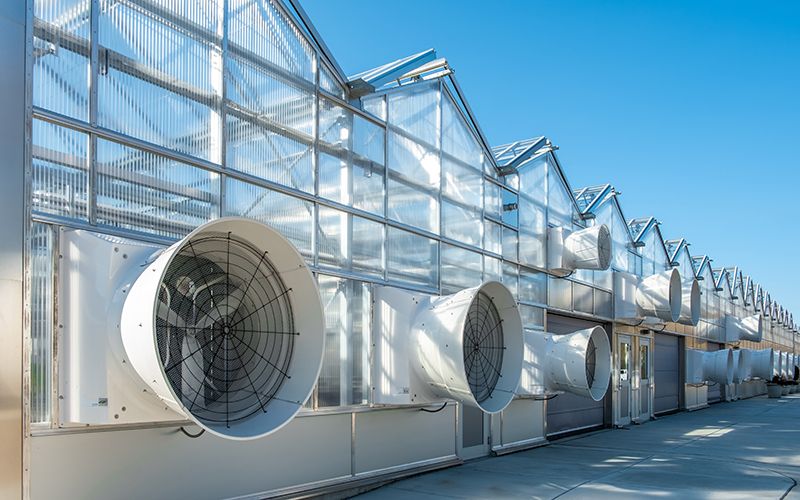
Exploring Natural and Mechanical Ventilation in Greenhouses
|
|
Time to read 5 min
 You are being redirected to QC Supply Pharmacy, where you’ll find a wide selection of high-quality prescription and pharmaceutical products for animals of all sizes.
Enjoy the same great service and expertise you trust from QC Supply.
Click below to continue shopping.
Continue
No thanks, stay on the main site
Powered by
You are being redirected to QC Supply Pharmacy, where you’ll find a wide selection of high-quality prescription and pharmaceutical products for animals of all sizes.
Enjoy the same great service and expertise you trust from QC Supply.
Click below to continue shopping.
Continue
No thanks, stay on the main site
Powered by


|
|
Time to read 5 min
Whether you have a small greenhouse or a large horticulture operation, proper greenhouse ventilation systems can determine your success or failure. Excessive greenhouse temperatures result in poor plant growth and the need for more frequent watering. There are many different ways to provide greenhouse ventilation to your greenhouse, from natural greenhouse ventilation to adding fans (mechanical greenhouse ventilation). Larger operations have both, running fans when the temperatures start to really rise.
Natural greenhouse ventilation depends on normal air movement created by wind pressures or gradients induced by differences in air temperatures between the growing area and outside of the greenhouse. The greatest potential for natural ventilation is during the winter months when the temperature difference inside to out is the greatest. Unfortunately, this occurs when the need for ventilation is the least. When the temperatures get to excessive levels, the outside temperatures may only be slightly cooler than inside your greenhouse. Natural ventilation is site-specific; areas of naturally occurring breezes will provide the best opportunities for warm weather ventilation.
Wind, as we all know, is very unpredictable, making adequate temperature control very difficult to achieve. Knowing the meteorological information about your proposed horticulture site is essential in designing a natural greenhouse ventilation system in a new build. Some forms of natural ventilation include roll-up sides (hand or automatically operated), and ridge, roof, and sidewall vents.
Roll-up sides work best in hoop houses, making sure to have a good summer breeze and plenty of space between houses. It helps to have greenhouses designed with a vertical sidewall up to the height of the attachment rail to reduce the amount of rain that can drip in.
Greenhouses with roof and sidewall vents operate on the principle that heat is removed by a pressure difference created by wind and temperature gradients. Wind also plays a major role; a wind speed of 23 MPH can provide 80% or more of the ventilation. Wind passing over the roof creates a vacuum and sucks the heated air out of the vent. If sidewall vents are open, cool replacement air enters and drops to the floor level. If the sidewall vents are closed, cool air enters the bottom of the roof vent, and the heated air escapes out the top of the vent. Open-roof greenhouses use standard vent hardware and controls to operate the roof system.
A shade system may be needed on top of roll-up sides and vents for adequate cooling on hot, sunny days. If you install one, make sure it is porous enough so the heat generated below can escape through the shade material.
Before the heating season begins, vents should be adjusted so they close evenly and tightly. Poor closing vents result in significant heat loss during the winter.
Mechanical greenhouse ventilation systems with properly designed inlets can provide excellent temperature control in all seasons, especially if that system can be easily automated with the use of computer-based controls. Fans work best if the draw is less than 150 feet. For most greenhouses, this means installing fans on one end wall with louvers placed on the opposite end. Longer houses will require sidewall louvers so air can be drawn through louvers on both ends.
Where possible, fans should be located to allow them to work with the prevailing summer wind. A reduction in output of 10% or more occurs when a fan is exhausting into the wind. Locate the fans so that the air flows over and through the plant canopy rather than under the benches or on the ridge of the greenhouse. The bottom of the fan or louver should be located about 3 feet above the floor.
Improper sizing of fans is a major cause of poor ventilation in many greenhouses. The fan ventilation system should be sized to provide one volume of air exchange per minute to a height of 8 feet for summer ventilation. This will result in an 8-10° F rise from the intake louver to the fan. You will also need to make sure you have enough fans for the size of your operation. Energy can also be saved by using larger fans with smaller motors. For example, a 36" diameter fan with a 1/3 horsepower motor will give the same output as a 30" fan with a 1/2 horsepower motor with a saving in electricity of 180 watts/hr.
Maintenance of the fans should be done on a regular basis. This includes cleaning blades, removing grass or weeds in front of shutters, and adjusting fan belts. Dirty, automatic shutters which do not fully open greatly restrict airflow and drastically lower a fan's ventilating efficiency. If these shutters do not close tightly when the fan is off, they will significantly increase the winter heating bill by allowing the infiltration of the cold outside air.
Keep the greenhouse full of plants to increase evaporative cooling from plant transpiration. High temperature/power failure alarms should be checked on a regular basis. During a hot summer day, it takes only a few minutes without ventilation to create temperatures in excess of 100° F.
During those weeks when the temperatures reach excessive levels, even the best-designed mechanical greenhouse ventilation systems will struggle to keep up, pushing inside greenhouse temps 10-20° F over outside temperatures. Evaporative cooling in greenhouses uses heat in the air to evaporate the water from the leaf and other wetted surfaces to cool the greenhouse 10-20° F below outside temperatures. This works best with the humidity in the outside air is low.
In the most common cooling system (fan and pad), the fans draw air through wet pads that extend the length of one endwall or sidewall. Aspen and coated cellulose are common pad materials that usually have a life of 1-3 years. Approximately one square foot of pad is needed for 20 square feet of floor area. Follow these steps in your own greenhouse to get your grow operation to the ideal temperature year-round.
Greenhouses can be game-changers for gardeners, particularly those of us who live in the northern half of the country with a frustratingly short growing season. But just having a greenhouse won’t guarantee that your plants will thrive; you must ensure they have a healthy growing environment with plenty of fresh air circulation in addition to their other, more obvious essentials for growth.
We offer a number of different types of greenhouse fans – stir, basket, exhaust, ceiling, shutters, inlets, and more, as well as all the equipment needed to keep your fans running smoothly. If you need assistance either designing your own greenhouse ventilation system or setting up a new build, give our experts a call at 888.433.5275. Leave all of your tips and additional questions on this topic below.
Information from this blog taken from posts from the UMass Extension Greenhouse Crops & Floriculture Program and Rutgers University.